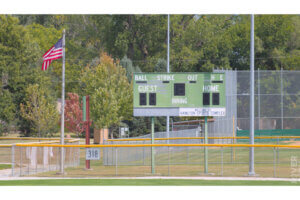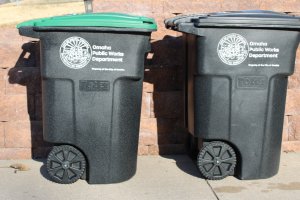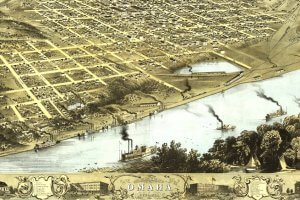Omaha does not have a major amusement park. Our medium sized park is Fun-Plex. However our history is chocked full of smaller venues and thrills. There are no roller coasters in Nebraska today, how about that?
The closest major amusement parks are Adventureland near Des Moines, IA and Worlds of Fun near Kansas City, MO.
This is a map showing all locations.

Former Amusement Parks
Carter Lake (the lake) has a fascinating past as an amusement destination. Both north and south of the lake, under both Nebraska and Iowa jurisdictions, there have been several parks with rides and many with water activities. Three of them are listed here because they featured rides: Courtland, Lakeview, and Pleasure Pier/Kiddieland.
Here is a quick timeline comparison for the parks.

Courtland Beach
1889-1905 | 9th and Q, Carter Lake, IA
Courtland had a roller coaster, perhaps the first one in the Omaha metro. Like many early amusement parks, the park focused on recreational activities like boating and dancing. The rides from this amusement park contributed to the opening of Lakeview in 1917. [North Omaha History]
Krug Park

1895-1940 | 52nd and Maple, Omaha
“The park had a modest start in 1895 when German immigrant George Tietz bought land near what is now 52nd and Maple streets to create Tietz Park. He installed a beer garden and dance hall before later adding a bowling alley. When Tietz died in 1903, the land went to brewery owner Frederick Krug of the Frederick Krug Brewing Co.” [Omaha Magazine]
Disaster: July 24th, 1930, four riders of the “Big Dipper” died when the roller coasters train fell 35 feet to the ground.
Krug Park closed in 1940 and is now the location of Gallagher Park.
Lakeview Amusement Park and Sand Point Beach
1917-1933 | 17th and Q, Carter Lake, IA
Sand Point Beach opened in 1906 on the south side of Carter Lake, on the Iowa side, with a dancing pavilion and some minor rides.
At the same site, Lakeview Amusement Park opened when Munchhoff moved the rides from Courtland Beach to Sand Point. The Jack Rabbit roller coaster was located here.
Peony Park

1919-1994 | 78th & Cass, Omaha | image credit: Aerials Around Peony Park
For much of its life, Peony Park was the amusement park in Nebraska. The name refers to Rosenfeld Peony Gardens, a 25 acre peony farm several blocks to the south. Like most amusement parks, it started as a gathering place with swimming pools and dance halls. The only adult roller coaster, Galaxy Orbit, operated from 1972-1993.
Segregation: The park remained segregated until 1963. To learn more, read Flashback Friday: NAACP Youth Council’s Peaceful Swimming Pool Protest Deemed “hysteria” in 1963 Omaha.
Peony Park closed in 1994 and is now the location of Peony Park shopping plaza. YouTube video for your learning adventure: The Rise and Fall of Peony Park. More history and videos.
Dodge Park Playland

1948-1970 | Ave A near the Missouri River, Council Bluffs, IA
“The park was started by brothers Abe and Louis Slusky on 14 acres on the north side of the Iowa approach of the Ak-Sar-Ben Bridge (US Highway 5 over the Missouri River). The park grew to 60 acres until 1964 when the park was reduced to 20 acres to make room for the building of Interstate 480. The wooden roller coaster was removed, but the midway did reopen the following year with a dozen rides. In 1970 Abe Slusky died of a heart attack. This was the end of amusement park and the rides where moved to Frontier City in Oklahoma City which the brothers had purchased the year before. The race track continued to operate after the amusement rides were removed until it closed in 1977. Today the area is a city park.” [Roller Coaster Database]
There were four roller coasters at the park, but maximum three at any time.
The park was closed after owner Abe died and the rides moved to Oklahoma [Wikipedia]. The park is now Tom Hanafan River’s Edge Park.
Lake Manawa (Playland?)
This roller coaster image is from 1910, supposedly outside of Lake Manawa (as found on Facebook). From a Historical Society brochure (PDF), I gather that the lake became a destination after 1887 when Lake Manawa Railway started an amusement park on ten acres. There were dance halls, soda shops, a hotel, and that roller coaster called Dip The Dips. The Grand Plaza was on the north shore and had a 600′ long boardwalk.

This video from Council Bluffs Revealed paints the picture of Lake Manawa, Coney Island Of The Midwest.
Pleasure Pier and Kiddieland
1949-1959 | North 13th near Carter Lake on the Nebraska side
Opened by the Carpenters via a lease from the City of Omaha, Carter Lake Pleasure Pier was a smaller competitor to the more popular Peony Park at the other edge of town. The park later opened a section called Kiddieland that featured many kids’ rides. The picnic facilities could host thousands. [North Omaha History]
Current Amusements
Fun Plex
7003 Q Street, Omaha, NE 68117 | 402-331-8436
Started as Kart Ranch in 1979, Fun-Plex is home to small rides, an arcade, and a water park. [Wikipedia for some history.] Some highlights:
- Go carts
- Bumper carts
- Carnival rides
- Kids rides
- Putt-Putt
- Water slides
- Lazy river
- Wave pool
- Rentable cabanas
- Swim up bar (21+ obviously)
“Big Ohhhh…” Roller Coaster: purchased from another park, Fun-Plex had a roller coaster from 2007-2018.
Never-Built Parks
Wild Escape at Port Nebraska, version 2002? A Steve Minard project that would put an amusement park along Abbott Drive – the area has since been built up as North Downtown/Millwork Commons. More from ultimaterollercoaster.com. Wild Escape, version 2005? Steve Minard may have found a lot in Council Bluffs where the drive-in used to be. But alas this also fell through. This was followed by a suggestion of Sarpy County, near I80, close to where Cabelas was built.
Steve Minard has attempted some version of Wild Escape in other states as well (like West Virginia), but none of them have succeeded. I saved this picture, so at least we have that, right?





